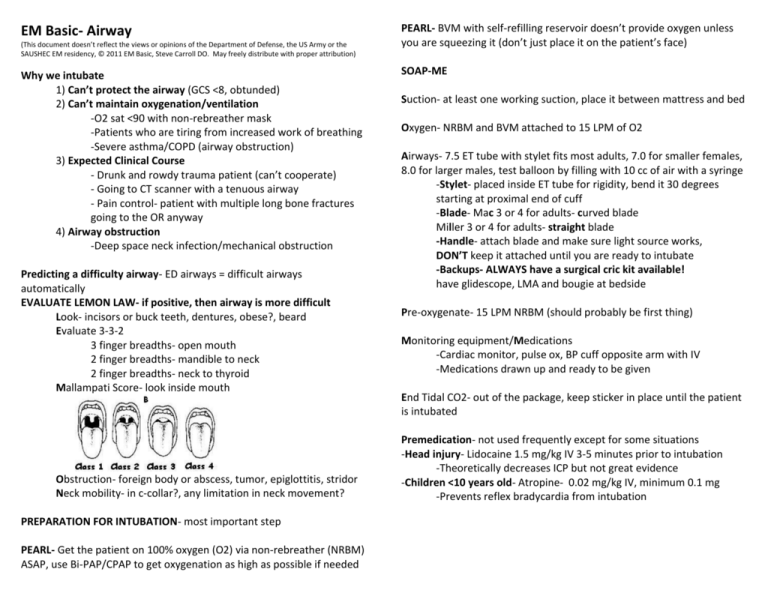Airway show notes (Word format)
advertisement

EM Basic- Airway (This document doesn’t reflect the views or opinions of the Department of Defense, the US Army or the SAUSHEC EM residency, © 2011 EM Basic, Steve Carroll DO. May freely distribute with proper attribution) Why we intubate 1) Can’t protect the airway (GCS <8, obtunded) 2) Can’t maintain oxygenation/ventilation -O2 sat <90 with non-rebreather mask -Patients who are tiring from increased work of breathing -Severe asthma/COPD (airway obstruction) 3) Expected Clinical Course - Drunk and rowdy trauma patient (can’t cooperate) - Going to CT scanner with a tenuous airway - Pain control- patient with multiple long bone fractures going to the OR anyway 4) Airway obstruction -Deep space neck infection/mechanical obstruction Predicting a difficulty airway- ED airways = difficult airways automatically EVALUATE LEMON LAW- if positive, then airway is more difficult Look- incisors or buck teeth, dentures, obese?, beard Evaluate 3-3-2 3 finger breadths- open mouth 2 finger breadths- mandible to neck 2 finger breadths- neck to thyroid Mallampati Score- look inside mouth Obstruction- foreign body or abscess, tumor, epiglottitis, stridor Neck mobility- in c-collar?, any limitation in neck movement? PREPARATION FOR INTUBATION- most important step PEARL- Get the patient on 100% oxygen (O2) via non-rebreather (NRBM) ASAP, use Bi-PAP/CPAP to get oxygenation as high as possible if needed PEARL- BVM with self-refilling reservoir doesn’t provide oxygen unless you are squeezing it (don’t just place it on the patient’s face) SOAP-ME Suction- at least one working suction, place it between mattress and bed Oxygen- NRBM and BVM attached to 15 LPM of O2 Airways- 7.5 ET tube with stylet fits most adults, 7.0 for smaller females, 8.0 for larger males, test balloon by filling with 10 cc of air with a syringe -Stylet- placed inside ET tube for rigidity, bend it 30 degrees starting at proximal end of cuff -Blade- Mac 3 or 4 for adults- curved blade Miller 3 or 4 for adults- straight blade -Handle- attach blade and make sure light source works, DON’T keep it attached until you are ready to intubate -Backups- ALWAYS have a surgical cric kit available! have glidescope, LMA and bougie at bedside Pre-oxygenate- 15 LPM NRBM (should probably be first thing) Monitoring equipment/Medications -Cardiac monitor, pulse ox, BP cuff opposite arm with IV -Medications drawn up and ready to be given End Tidal CO2- out of the package, keep sticker in place until the patient is intubated Premedication- not used frequently except for some situations -Head injury- Lidocaine 1.5 mg/kg IV 3-5 minutes prior to intubation -Theoretically decreases ICP but not great evidence -Children <10 years old- Atropine- 0.02 mg/kg IV, minimum 0.1 mg -Prevents reflex bradycardia from intubation RAPID SEQUENCE INTUBATION- how we intubated in the ED Paralytics- rapidly after sedative meds #1 point is that you DO NOT bag the patient once they go apneic Succhinylcholine (“suxs”)- depolarizing paralytic (initially binds to motor endplate and causes depolarization then relaxation Most favored paralytic for ED RSI Dose- 1.5 – 2 mg/kg IV, 3-4 mg/kg IM Onset- 60 seconds Duration- 4-5 minutes Considerations- causes transient rise in potassium, use with caution in those on dialysis, crush injuries or burns more than 24 hours old, patients with a history of malignant hyperthermia or muscular dystrophy Overall- rapid administration of sedative followed by paralytic to produce unconsciousness and reduce aspiration risk PEARL- Don’t need RSI in patients in cardiac arrest PEARL- Dose medications off patients actual body weight- 20 of etomidate and 100 of suxs won’t be enough for everyone Sedative medications Etomidate- ultra short active sedative Most favored for ED RSI Dose- 0.3 mg/kg IV Onset- 30-45 seconds Duration- 10 minutes Considerations- single dose with cause adrenal suppression but probably not clinically significant, biggest concern is in sepsis (can use ketamine) Ketamine- PCP derivative- analgesia and sedation- dissociative agent Patient maintains airway reflexes, good for asthmatics (bronchodilator) Dose- 1-2 mg/kg IV or 3-4 mg/kg IM Onset- 30-45 seconds Duration- 30 minutes Considerations- concern that it causes ICP rise but this is being debunked, some won’t use it in head injured patients Propofol- ultra short acting hypnotic with NO analgesic properties Very rapid onset and very short duration of action Dose- 1mg/kg IV rapid push Duration- 3-4 minutes Considerations- causes hypotension so use caution in patients who are already hypotensive, excellent to use for post intubation sedation Rocuronium- non-depolarizing paralytic (competitive inhibitor that competes for motor end plate sites with acetylcholine) Dose- 1.2 – 1.5 mg/kg IV Onset- 60 seconds Duration- 30-45 minutes Considerations- causes long paralysis, some prefer suxs so that the patient recovers from the paralysis if ET tube can’t be placed Vecuronium- non-depolarizing paralytic- not used frequently for RSI but can be used for long term paralysis if needed Dose- 0.1 mg/kg IV but 10 mg IV is a common dose across the board Onset- 2-3 minutes Duration- 45 – 60 minutes Considerations- don’t use it routinely, titrate sedation aggressively to ensure patient is awake but paralyzed Intubation- make sure your SOAP-ME is complete, quiet the room, check with your RT, medication nurse, and assistant to make sure they are ready, have an assistant to your right who does nothing but assist you Give medications- 20 of etomidate, 100 of suxs is a common dose for the “average” 70 kilogram adult Keep NRBM on until you intubate- although you don’t want to bag the patient a lot, your supervisor may ask for one or two breaths to ensure that bagging the patient is possible Hold the blade in your LEFT hand (even if you are left handed) Open the patient’s mouth -Use 1st and 3rd fingers to scissor open the mouth ******NEVER ROCK BACKWARDS WITH THE BLADE****** Slowly advance the tip of the blade down the right side of the tongue Use a sweeping motion to move tongue upwards Look for your structures Identify the epiglottis For Mac blade- place blade tip anterior to epiglottis -For miller blade- directly lift up the epiglottis Best reference for this- airwaycam.com on YouTube PEARL- you are not “muscling” the tongue upwards, if you place the tip of the blade in the vallecula it will move the epiglottis upwards, if you have to lift a little bit, go upwards towards the ceiling and towards the back left hand corner of the room Once you see cords- ask for the tube without looking away Use bimanual laryngoscopy -Have assistant place fingers on thyroid cartilage and you move their fingers until you get the best view, whatever direction you need to get the best view Insert the tube -Pass through the right side of the mouth, place balloon just past the cords and have your assistant inflate it -Tube depth- 3 times the tube length- (7.0 ET tube = 21 cm) Confirm placement -Use end-tidal CO2 detector- yellow= YES, check the stomach for breath sounds then bilateral breath sounds on the chest and look for equal chest rise and fall -Order a post-intubation chest x-ray Failure to intubate -Misplacement of the tube isn’t deadly but not recognizing it is -If patient desats, bag the patient -Prep the neck for a surgical cric ****IF YOU CAN’T BAG THE PATIENT, THEY NEED A SURGICAL CRIC**** -If you can bag the patient, make a 2nd attempt, have the cric tray and an LMA available How to do a cric- search YouTube for “bougie assisted cric” Initial vent settings-A/C mode (assist/control) -Tidal volume- 6-8 cc/kg of IDEAL body weight (lung volumes in a 5 foot patient the same if they are 100 pounds or 500 pounds) -“Average” 70 kg adult= 500 cc -FiO2- 100 percent initially, work to titrate down as you can -PEEP- 5 initially, 0 PEEP for asthmatic -Initial settings- A/C tidal volume 500, 100 percent FiO2, 5 of PEEP Post-intubation sedation and analgesia Try to have this prepared BEFORE you intubate so your patient doesn’t wake up (etomidate only lasts 10 minutes) Propofol- easy on/easy off- caution in hypotensive patients Give bolus 0.5 – 1 mg/kg IV then 20 mcg/kg/min and titrate upwards Versed- longer acting, harder to titrate Give bolus 5mg IV then drip at 5 mg/hr Fentanyl- provides analgesia- having a tube in your throat hurts! Titrate 50-100 mcg IV (1 mcg/kg), less hypotension than morphine Adjuncts -Bougie- if you can’t see cords but you can see aretynoid cartilages, insert the bougie and then insert the ET tube over the bougie References: The Manual of Emergency Airway Management- Dr Ron Walls, et. al. Airway Cam Pocket Guide to Intubation- Dr. Richard Levitan Contact: steve@embasic.org




